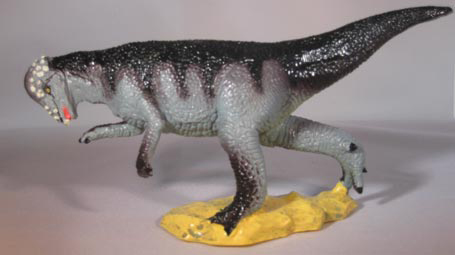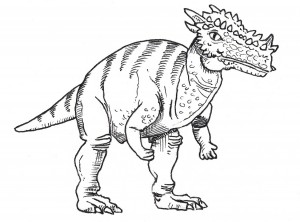Pachycephalosaurs – New Study Suggests Bone-heads Bashed Each Other in Different Ways
Study of Pachycephalosaur Skulls Sheds Light on Dinosaur Behaviour
The “Bone-headed” dinosaurs, otherwise known as pachycephalosaurids were a group of Cretaceous ornithischian dinosaurs related to the horned dinosaurs (members of the Marginocephalia). Most of what palaeontologists know about these dinosaurs has come from fossils of these animal’s thickened, and in some cases domed skulls. In a paper presented at the Society of Vertebrate Palaeontology (United States), in a conference held in North Carolina, a research team have suggested that the pathology found on the skulls of these dinosaurs indicate that these animals did indeed butt each other. In addition, the scientists propose that lesions and scars on different parts of the skull indicate that different types of Pachycephalosaur may have used butting contests in different ways.
Pachycephalosaurs – Skull Study Sheds Light on Potential Intraspecific Combat
Picture credit: Everything Dinosaur
Although examples of pachycephalosaurs such as Dracorex and the largest known – Pachycephalosaurus are often featured in children’s dinosaur books, the remains of these dinosaurs are extremely rare in the fossil record. Apart from elements of the skull, only a few other body fossils ascribed to this type of dinosaur have been found. One of the most complete fossil specimens was that of a pachycephalosaur named as Stegoceras (Stegoceras validum). Fossils of this bone-headed dinosaur have been found in the Dinosaur Provincial Park Formation (Alberta, Canada), indeed most of the illustrations of all pachycephalosaurs are based on interpretations of Stegoceras fossil material.
Pachycephalosaurid Skull Study
These bipeds are characterised by a thickening of the dermal skull roof, particularly the frontal and parietal bones. These bones are to be found at the top and towards the back of the head. In a number of genera this thickening is accompanied by distinctive bumps and ridges that are found on the postorbital, squamosal and other facial bones. Palaeontologists have speculated for many years as to what these bizarre skull structures were used for.
Dr Joseph Peterson (University of Wisconsin) and his colleague Collin Dischler, who has researched pathology on dinosaur skulls, presented the paper at the Society of Vertebrate Palaeontology’s annual meeting held in Raleigh. After examining one pachycephalosaur skull, the team went onto compare the pathology found on this specimen with those of other pachycephalosaurs. They also studied the skulls of extant animals such as birds, crocodiles and mammals looking for similar types of injury and signs of damage.
The research team looked at the over one hundred pachycephalosaur specimens from North America and Asia. Of these twenty-three had signs of injury. A three-dimensional computer generated model of the skulls were made and the lesions and injuries mapped onto them. From this model, the team noticed that the placement of the injuries depended on the morphology, the shape of the skull. Fossilised skulls with low domes tended to have injuries towards their front, whilst skulls with higher domed structures tended to show an even spread of injuries from the front to around the back.
Using the Skulls in Different Ways
The team’s findings indicate that pachycephalosaurs with different shaped skulls may have used their heads in butting contests in different ways. Commenting on the scientific paper, Dr Peterson stated:
“The lesions we were seeing were strikingly similar to those that we often see on the skulls of modern mammals that ram heads.”
Earlier studies had concluded that some skulls of pachycephalosaurs were not suited to direct head-butting combat. It had been speculated that some types of pachycephalosaurs may have indulged in flank-butting contests to settle disputes amongst herd members. Most scientists believe that it was only the males that indulged in such behaviours, after all, such contests seen today amongst bovines and ovines (cattle and sheep) tend to be limited to only the males of the species.
To read an article on an earlier study into the skulls of pachycephalosaurs: Striking a Blow for Head-Butting Pachycephalosaurs.
When the behaviour of modern animals in intraspecific combat (competition between animals of the same species) was studied, in seems that certain animals such as the North American Bison (B. bison) wrestle with their horns in direct head-to-head battles, whereas other animals such as the North American Mountain Goat (Oreamos americanus) resolve disputes by bumping one another along the flanks. Dr Peterson and his co-researchers have concluded that the high-domed pachycephalosaurs with signs of injury in the parietal area of their skulls were bumping the flanks of their rivals. The team suggests that a dinosaur such as Pachycephalosaurus wyomingenis with its twenty-five centimetre thick skull may have been a “flank bumper”. Other types of pachycephalosaur whose skulls show injury to the bones slightly forward of the parietal bone were probably animals that conducted front-on wrestling matches with each other, in a similar fashion to modern North American Bison.
Did Different Types of Pachycephalosaurid Butt in Different Ways?
Picture credit: Everything Dinosaur
Lack of Fossils to Study
The lack of extensive pachycephalosaur fossil material to study weakens the arguments put forward to some degree. Andrew Farke, a vertebrate palaeontologist at the Raymond Alf Museum (Claremont, California), commented that the different species resolving intraspecific disputes in different ways could actual be a single species with adult and juvenile skulls showing different pathologies.
He stated:
“It could be that we are seeing two different species bashing in different ways, but it could also be a single dinosaur species where juveniles and adults exhibit different bashing behaviours.”
One of the problems scientists face when studying the fossils of this particular group of dinosaurs is that the skulls may have been transported and deposited a long way from where the animal actually lived. A number of specimens show signs of having been eroded as a result of the action of being bumped along a river bed. It has been speculated that these herbivorous dinosaurs lived in dry, mountainous regions.
The lack of fossils could be explained by such areas having a poor preservation potential for fossil material. Occasionally the remains of a pachycephalosaur would be washed downstream as a result of a flood or similar event. The tough, thick skull bones being more robust than the other parts of the skeleton were the only bones to survive this physical process. As the skulls were subjected to erosion the skull bones would have been bashed and chipped. Other palaeontologists who have read the paper associated with this study have concluded that some of the injuries attributed to butting contests could have been made after the animal’s death (post mortem). The skulls may have been chipped and damaged whilst being transported to their final resting place downstream.
Dr Farke has concluded that evidence as to whether these lesions were caused post mortem can be gathered when the skull bone microstructure is examined using high magnification CT scans. Such analysis would provide evidence of some of the injuries beginning to heal, indicating that the lesions occurred when the dinosaur was very much alive.
It is likely that the debate over the pachycephalosaurs and their bizarre skulls is likely to go on, with palaeontologists “locking horns” as they argue over the evidence.
For models and figures of pachycephalosaurid dinosaurs and other prehistoric animals: Wild Dinos Figures (Safari Ltd).



